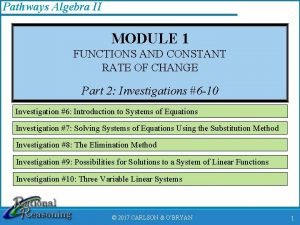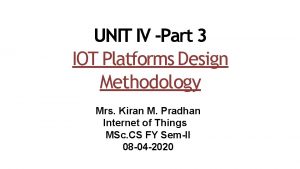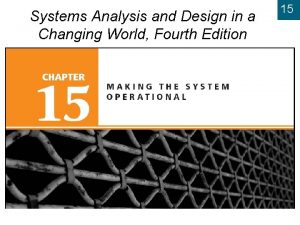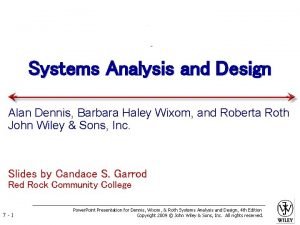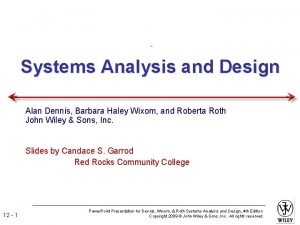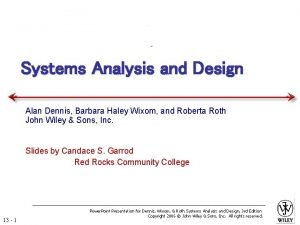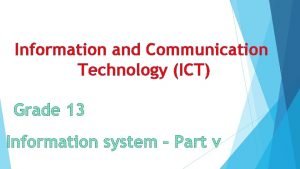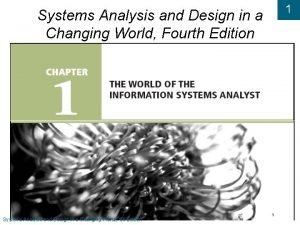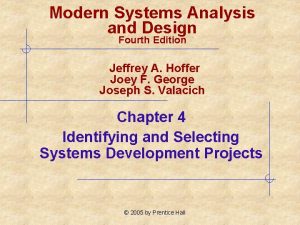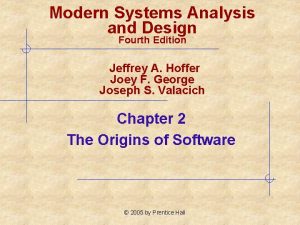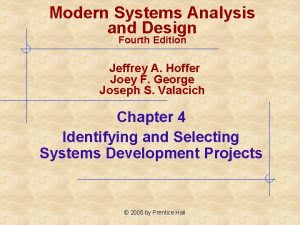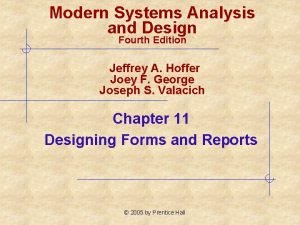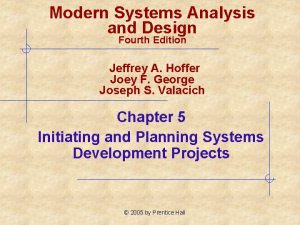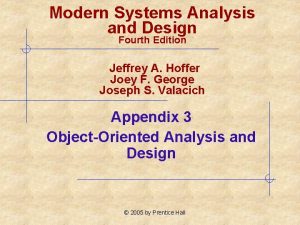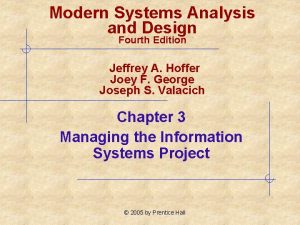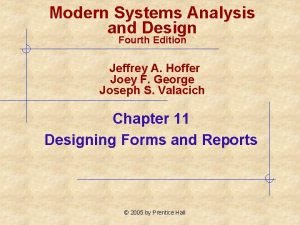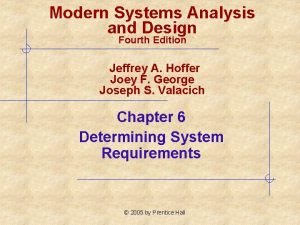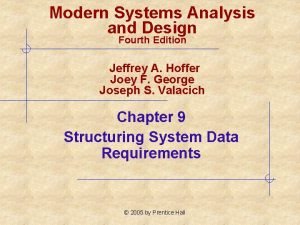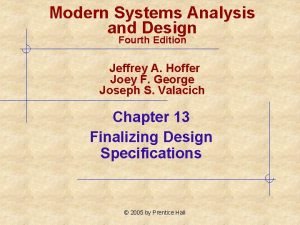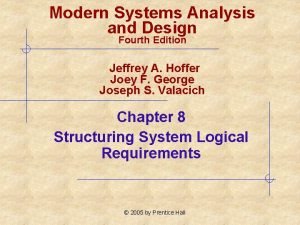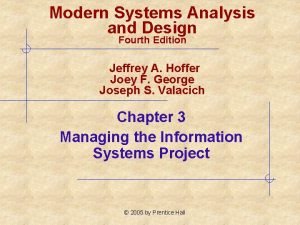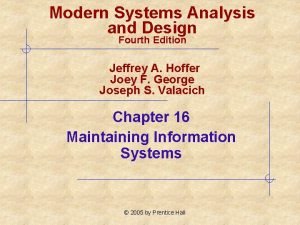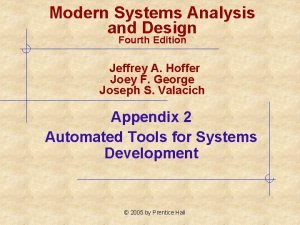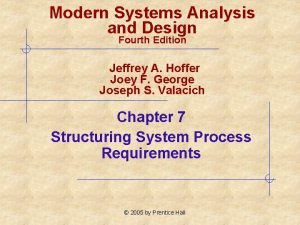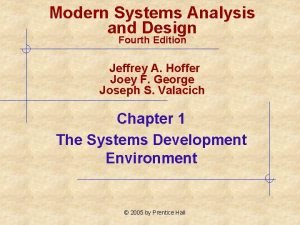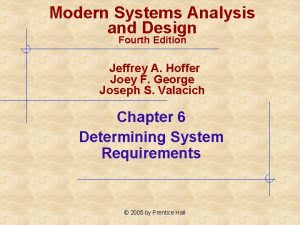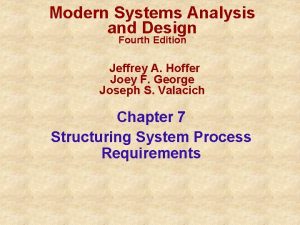Modern Systems Analysis and Design Fourth Edition Jeffrey













































- Slides: 45

Modern Systems Analysis and Design Fourth Edition Jeffrey A. Hoffer Joey F. George Joseph S. Valacich Appendix 1 Succeeding as a Systems Analyst © 2005 by Prentice Hall

Learning Objectives 1. Describe the organizational roles involved 2. 3. 4. 5. 6. in information systems development. Discuss analytical skills required for success as a systems analyst. Discuss technical skills required for success as a systems analyst. Discuss management skills required for success as a systems analyst. Discuss interpersonal skills required for success as a systems analyst. Describe the systems analysis profession. Appendix 1 -2 © 2005 by Prentice Hall

The Role of the Systems Analyst Skills required: analytical, technical, managerial, interpersonal Liaison between users, programmers, and other systems professionals Appendix 1 -3 © 2005 by Prentice Hall

Appendix 1 -4 © 2005 by Prentice Hall

Characteristics of Successful Teams Diversity in background, skills, and goals Tolerance of diversity, ambiguity, and uncertainty Clear and complete communication Trust Mutual respect Reward system that encourages shared responsibility Appendix 1 -5 © 2005 by Prentice Hall

Appendix 1 -6 © 2005 by Prentice Hall

Major Information Systems Development Roles IS department manager Systems analysts Programmers Business managers Other IS managers/technicians Stakeholders Appendix 1 -7 © 2005 by Prentice Hall

Analytical Skills for Systems Analysis Four Sets of Analytical Skills: n n 2. 8 Systems Thinking Organizational Knowledge Problem Identification Problem Analyzing and Solving Appendix 1 -8 © 2005 by Prentice Hall

What is a System? A group of interrelated procedures used for a business function, with an identifiable boundary, working together for some purpose. Appendix 1 -9 © 2005 by Prentice Hall

Appendix 1 -10 © 2005 by Prentice Hall

Characteristics of Systems Boundary: divides system from environment Inputs: data from environment to system Output: data from system to environment Components: subparts of systems operating independently (also called subsystem) Interrelationships: associations between components of a system Interfaces: point of contact between system and environment, or between subsystems Constraints: limit to what a system can accomplish Purpose: overall goal or function of a system Environment: everything external to the system that interacts with it Appendix 1 -11 © 2005 by Prentice Hall

Important System Concepts Decomposition: breaking down a system into smaller constituents Modularity: the result of decomposition; parts of a system Coupling: dependencies between subsystems Cohesion: extent to which a subsystem performs a single function Appendix 1 -12 © 2005 by Prentice Hall

Decomposition and modularity make systems easier to understand, analyze, design, and maintain. Appendix 1 -13 © 2005 by Prentice Hall

Logical and Physical Descriptions Logical System Description n n Portrays the purpose and function of the system Does not tie the description to a specific physical implementation Physical System Description n Focuses on how the system will be materially constructed Appendix 1 -14 © 2005 by Prentice Hall

Organizational Knowledge Understanding of how organizations work Knowledge of specific functions and procedures of organization and department How work officially gets done Internal policies Competitive and regulatory environment Organizational strategies and tactics Appendix 1 -15 © 2005 by Prentice Hall

Problem Identification Problem is the difference between an existing situation and a desired situation. Identification is process of defining differences. Differences are defined by comparing the current situation to the output of a model that predicts what the output should be. Appendix 1 -16 © 2005 by Prentice Hall

Herbert Simon’s Phases of Problem Solving Intelligence n All relevant information is collected. Design n Alternatives are formulated. Choice n Best alternative solution is chosen. Implementation n Solution is put into practice. Appendix 1 -17 © 2005 by Prentice Hall

Appendix 1 -18 © 2005 by Prentice Hall

Technical Skills for Systems Analysis Constant re-education is necessary as technology changes rapidly. Activities to keep skills up-to-date: n n n n Trade publications Professional societies Attend classes or teach at a local college Attend courses sponsored by organization Conferences and trade shows Browse Websites Participate in new groups and conferences Appendix 1 -19 © 2005 by Prentice Hall

Technical Skills for Systems Analysis (cont. ) Understanding of a wide variety of technologies is required: n n n n Microcomputers, workstations, minicomputers and mainframe computers Programming languages Operating systems Database and file management systems Data communication standards Systems development tools and environments Web development languages and tools Decision support system generators Appendix 1 -20 © 2005 by Prentice Hall

Management Skills for Systems Analysis Four categories: n n Resource Management Project Management Risk Management Change Management Appendix 1 -21 © 2005 by Prentice Hall

Resource Management Systems analyst needs to know how to get the most out of the resources of an organization, including team members. Includes the following capabilities: n n n Predicting resource usage Tracking resource consumption Using resources effectively Evaluation of resource quality Securing resources from abusive use Relinquishing resources when no longer needed Appendix 1 -22 © 2005 by Prentice Hall

Project Management Two Goals: n n Prevent projects from coming in late Prevent projects from going over budget Assists management in keeping track of project’s progress Consists of several steps: n n n Decomposing project into independent tasks Determining relationships between tasks Assigning resources and personnel to tasks Appendix 1 -23 © 2005 by Prentice Hall

Risk Management Ability to anticipate what might go wrong in a project Minimize risk and/or minimize damage that might result Placement of resources Prioritization of activities to achieve greatest gain Appendix 1 -24 © 2005 by Prentice Hall

Change Management Ability to assist people in making transition to new system Ability to deal with technical issues related to change n n Obsolescence Reusability Appendix 1 -25 © 2005 by Prentice Hall

Interpersonal Skills for Systems Analysis Mastery of interpersonal skills is paramount to success as a Systems Analyst Four types of skills: n n Communication skills Working alone and with a team Facilitating groups Managing expectations Appendix 1 -26 © 2005 by Prentice Hall

Communication Skills Effective communication helps to establish and maintain good working relationships with clients and colleagues Skills improve with experience Main types used by Systems Analyst: n n Interviewing and Listening Written and Oral Presentations Appendix 1 -27 © 2005 by Prentice Hall

Interviewing and Listening Means to gather information about a project Listening to answers is just as important as asking questions Effective listening leads to understanding of problem and generates additional questions Appendix 1 -28 © 2005 by Prentice Hall

Written and Oral Presentations Used to document progress of project and communicate this to others Communication takes several forms: n n n Meeting agenda Meeting minutes Interview summaries Project schedules and descriptions Memoranda requesting information Requests for proposals from vendors and contractors Appendix 1 -29 © 2005 by Prentice Hall

Steps to Improving Communication Skills Practice n n Conduct a training class Volunteer to speak Videotape presentation and do a selfappraisal of your skills Make use of college writing centers Take classes on business and technical writing Appendix 1 -30 © 2005 by Prentice Hall

Working Alone and with a Team Working alone on aspects of project involves managing: n n n Time Commitments Deadlines Team work involves establishing standards of cooperation and coordination Appendix 1 -31 © 2005 by Prentice Hall

Appendix 1 -32 © 2005 by Prentice Hall

Facilitating Groups Involves guiding a group without being a part of the group Useful skill for sessions such as Joint Application Development (JAD) Appendix 1 -33 © 2005 by Prentice Hall

Guidelines for Effective Meetings Be comfortable with facilitator role. Make sure group understands expectations. Use physical movement to indicate where to focus. Give thanks and respect for participation. Ask questions instead of making statements. Be a patient and good listener. Keep the group focused. Encourage group members to feel ownership of goals and outcomes. Appendix 1 -34 © 2005 by Prentice Hall

Managing Expectations Managing expectations is directly related to successful system implementation. Skills for successful expectation management: n n n Understanding of technology and workflows Ability to communicate a realistic picture of new system to users Effective education of management and users throughout systems development life cycle Appendix 1 -35 © 2005 by Prentice Hall

Systems Analysis as a Profession Standards have been established for education, training, certification and practice. Several aspects: n n n Standards of Practice Ethics Career Paths Appendix 1 -36 © 2005 by Prentice Hall

Standards of Practice Endorsed Development Methodology n n Specific procedures and techniques are to be used during development process. Promote consistency and reliability across all of an organization’s development projects. Approved Development Platforms n Organizations standardize around a specific platform, sometimes tied to development methodology. Appendix 1 -37 © 2005 by Prentice Hall

Standards of Practice Standardization of Roles n Roles are becoming better defined across organizations. Development of a Common Language n n Common programming languages Common modeling languages, such as Unified Modeling Language (UML) Appendix 1 -38 © 2005 by Prentice Hall

Ethics Professional Ethics n ACM Code of Ethics Business Ethics n Stockholder approach w Any action taken by a business is acceptable as long as it is legal and maximizes stockholder profit. n Stakeholder approach w Any action that violates rights of stakeholder must be rejected. n Social Contract approach w Any action that is deceptive, can dehumanize employees or that could discriminate is rejected. Appendix 1 -39 © 2005 by Prentice Hall

ACM Code of Conduct Appendix 1 -40 © 2005 by Prentice Hall

ACM Code of Conduct (cont. ) Appendix 1 -41 © 2005 by Prentice Hall

ACM Code of Conduct (cont. ) Appendix 1 -42 © 2005 by Prentice Hall

ACM Code of Conduct (cont. ) Appendix 1 -43 © 2005 by Prentice Hall

Career Paths Consulting Information Systems within a large corporation Software vendors Other opportunities outside of systems analysis Appendix 1 -44 © 2005 by Prentice Hall

Summary In this chapter you learned how to: 1. 2. 3. 4. 5. 6. Describe the organizational roles involved in information systems development. Discuss analytical skills required for success as a systems analyst. Discuss technical skills required for success as a systems analyst. Discuss management skills required for success as a systems analyst. Discuss interpersonal skills required for success as a systems analyst. Describe the systems analysis profession. Appendix 1 -45 © 2005 by Prentice Hall
 Modern systems analysis and design 7th edition
Modern systems analysis and design 7th edition Expert systems: principles and programming, fourth edition
Expert systems: principles and programming, fourth edition Case tools are limited to systems analysis.
Case tools are limited to systems analysis. Modern systems analysis and design
Modern systems analysis and design A modern approach to systems analysis and design
A modern approach to systems analysis and design Modern operating systems 3rd edition
Modern operating systems 3rd edition Modern operating systems tanenbaum 5th edition
Modern operating systems tanenbaum 5th edition Project 2 fourth edition
Project 2 fourth edition Pathways algebra 2 fourth edition answer key
Pathways algebra 2 fourth edition answer key Ethics in information technology fourth edition
Ethics in information technology fourth edition Ethics in information technology 6th edition answers
Ethics in information technology 6th edition answers Project 4 fourth edition
Project 4 fourth edition A computer programming team has 13 members
A computer programming team has 13 members 7 phases of the system development life cycle
7 phases of the system development life cycle Iot level specification
Iot level specification Hamlet soliloquies summary
Hamlet soliloquies summary Using mis (10th edition) 10th edition
Using mis (10th edition) 10th edition Chapter 1
Chapter 1 Systems analysis & design in an age of options pdf
Systems analysis & design in an age of options pdf Gantt chart system analysis and design
Gantt chart system analysis and design Systems analysis and design in a changing world
Systems analysis and design in a changing world System analysis and design in a changing world
System analysis and design in a changing world System analysis and design alan dennis
System analysis and design alan dennis Introduction to systems analysis and design
Introduction to systems analysis and design Ssadm tools
Ssadm tools Kendall & kendall systems analysis and design
Kendall & kendall systems analysis and design Systems analysis and design alan dennis
Systems analysis and design alan dennis Systems analysis and design alan dennis
Systems analysis and design alan dennis Systems analysis and design alan dennis
Systems analysis and design alan dennis Systems analysis and design alan dennis
Systems analysis and design alan dennis Systems analysis and design alan dennis
Systems analysis and design alan dennis Systems analysis and design alan dennis
Systems analysis and design alan dennis Systems analysis and design alan dennis
Systems analysis and design alan dennis Ssadm diagram
Ssadm diagram Radar range equation snr
Radar range equation snr Object-oriented systems analysis and design using uml
Object-oriented systems analysis and design using uml Patched-up prototype
Patched-up prototype System analysis and design in a changing world
System analysis and design in a changing world Systems analysis and design in a changing world
Systems analysis and design in a changing world Systems analysis and design in a changing world
Systems analysis and design in a changing world Systems analysis and design alan dennis
Systems analysis and design alan dennis Systems analysis and design alan dennis
Systems analysis and design alan dennis Systems analysis and design alan dennis
Systems analysis and design alan dennis Structured systems analysis and design method
Structured systems analysis and design method Essentials of systems analysis and design
Essentials of systems analysis and design Systems analysis and design in a changing world
Systems analysis and design in a changing world








